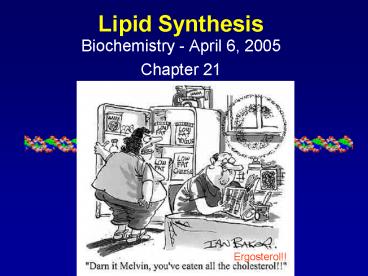Lipid Synthesis - PowerPoint PPT Presentation
1 / 14
Title:
Lipid Synthesis
Description:
Other fatty acids are derived from Palmitate. Because mammals do not have the ... tissue, DHAP produced by partial gluconeogenesis pathway - glyceroneogenesis ... – PowerPoint PPT presentation
Number of Views:816
Avg rating:3.0/5.0
Title: Lipid Synthesis
1
Lipid Synthesis
- Biochemistry - April 6, 2005
- Chapter 21
Ergosterol!!
2
Other Fatty Acids
- Other fatty acids are derived from Palmitate
- Because mammals do not have the desaturases
necessary to produce linoleate and a-linolenate,
these are essential fatty acids, must be present
in diet
3
Unsaturated Fatty Acids
- Double bonds introduced by mixed-function
oxidases - O2 used as an oxidant, accepts 2 electrons from
FA carbons being oxidized, 2 electrons from NADPH
4
Eicosanoids (20C)
- Arachidonate ? prostaglandin H2 (PGH2) catalyzed
by cyclooxygenase (COX) - PGH2 is a precursor for other prostaglandins
(inflammation) and thromboxanes (clotting) - Lipoxygenases (cytochrome P450 enzymes) add
both oxygen atoms to arachidonate to
synthesize leukotrienes (allergies,
hypersensitiveresponse).
5
Cytochrome P-450 enzymes
- P-450 enzymes contain heme, use O2 as a
substrate, can bind CO, resulting in maximum
absorbance at 450 nm. - Hundreds of family members, involved in
detoxifying many toxins, drugs (adds hydroxyl to
increase solubility, excretion) - Monooxygenases 1 O added to substrate, 1 forms
H2O - Dioxygenases both oxygen atoms added to
substrate
6
Triacylglycerols
- Glycerol phosphate synthesized 2 ways in
adipose tissue, DHAP produced by partial
gluconeogenesis pathway - glyceroneogenesis - 2 acyl groups transferred from CoA
- Phosphatidic acid isa precursor for
phospholipids and triglycerides
7
Fat cycling
- Top fatty acids released by adipose tissue,
excess FAs esterified into triglycerides by
liver, sent back to adipose. - Middle glucocorticoids (cortisol) increase
triglyceride synthesis in liver, decrease it in
adipose (via effect on PEP carboxykinase
expression) - High level of fatty acids in blood, interferes
with glucose metabolism Type 2 diabetes
insulin insensitivity - Bottom thiazolidine-dione drugs have effect
opposite of glucocorticoids
8
Phospholipid synthesis
- Phospholipids synthesized by linking either
diacylglycerol (DAG) or polar head group to CDP - 1 phosphate remains, CMP is leaving group (NAS)
9
Isoprenoid Synthesis
- Isoprenoids are lipids built from 5C isoprene
unit -includes sterols, lipophilic hormones,
hydrocarbon tail of quinones, chlorophyll - 3 acetyl-CoA ? mevalonate (6C) ? isopentenyl
pyrophosphate (IPP)(5C) CO2
10
IPP Synthesis
- HMG-CoA reductase is key regulated step,
mevalonate is committed to isoprenoid biosynthesis
- Stimulated by insulin
- Inhibited by glucagon, cholesterol lowering drugs
11
Isoprenoid Synthesis
- DMAP IPP ? GPP (10C)
- GPP -cyclase? terpenes
- GPP IPP ? FPP (15C)
- FPP cyclase? sesquiterpenes
- FPP IPP ? Geranylgeranyl pyrophosphate (GGPP)
(20C) - GGPP -cyclase? diterpenes
- FPP FPP ? squalene (30C)
- Squalene ? -cyclase? sterols
12
Sterols
- Different eukaryotes make different sterols
- Sigmasterol plants
- Ergosterol fungi
- Cholesterol animals synthesized primarily in
the liver
13
Lipoproteins
- Lipids are transported through blood is
association with lipoproteins. - Chylomicrons intestine ? tissues
- Remnants taken up and processed by liver
- VLDL Liver ? adipose, muscle
- Removal of triglycerides from VLDL ? LDL (rich in
cholesterol) - HDL transportscholesterol to liverfor removal
14
Liver Cholesterol
- Lipoproteins taken up by receptor-mediated
endocytosis - Cholesterol level in liver determines whether
more will be produced - Defect in LDL receptor prevents uptake, leads to
continual synthesis of cholesterol, accumulates
to high levels. - Optimal lipid profile
- Total cholesterol lt200 mg/dL
- HDL gt60 mg/dL
- LDL lt100 mg/dL
- Triglycerides lt150 mg/dL































